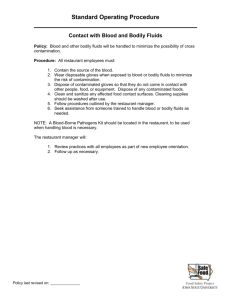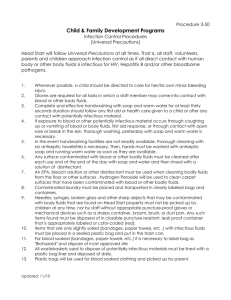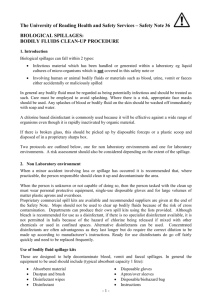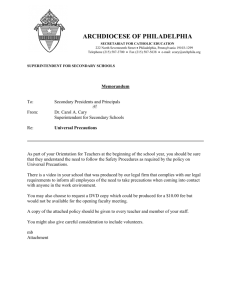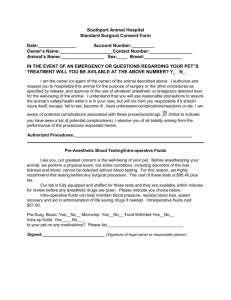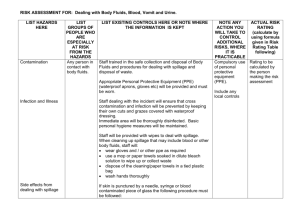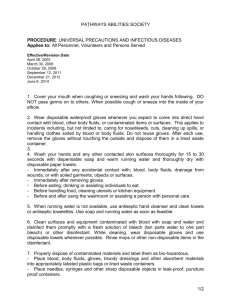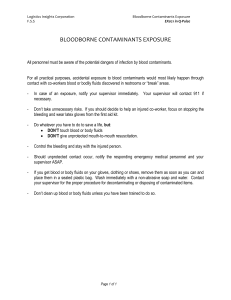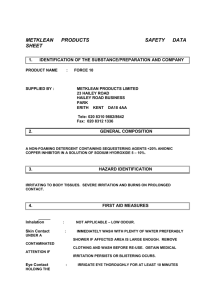Body Fluids Risk Assessment July 2015
advertisement
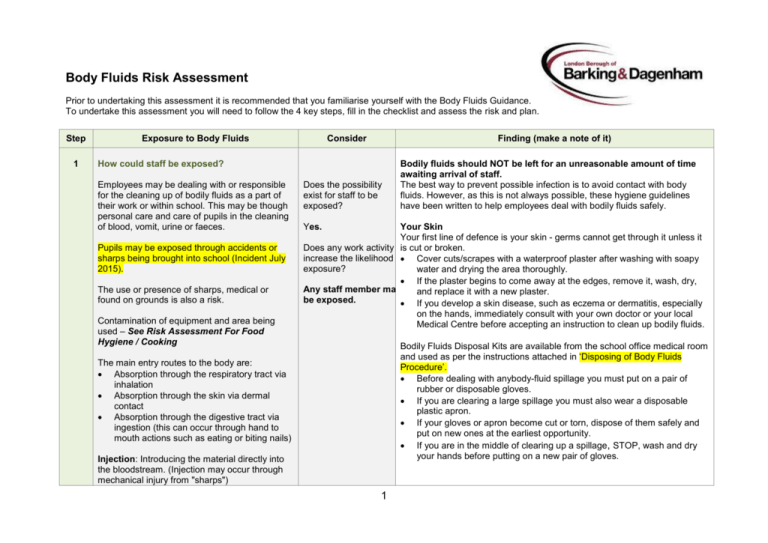
Body Fluids Risk Assessment Prior to undertaking this assessment it is recommended that you familiarise yourself with the Body Fluids Guidance. To undertake this assessment you will need to follow the 4 key steps, fill in the checklist and assess the risk and plan. Step 1 Exposure to Body Fluids Consider Finding (make a note of it) How could staff be exposed? Employees may be dealing with or responsible for the cleaning up of bodily fluids as a part of their work or within school. This may be though personal care and care of pupils in the cleaning of blood, vomit, urine or faeces. Pupils may be exposed through accidents or sharps being brought into school (Incident July 2015). The use or presence of sharps, medical or found on grounds is also a risk. Contamination of equipment and area being used – See Risk Assessment For Food Hygiene / Cooking Does the possibility exist for staff to be exposed? Bodily fluids should NOT be left for an unreasonable amount of time awaiting arrival of staff. The best way to prevent possible infection is to avoid contact with body fluids. However, as this is not always possible, these hygiene guidelines have been written to help employees deal with bodily fluids safely. Yes. Your Skin Your first line of defence is your skin - germs cannot get through it unless it Does any work activity is cut or broken. increase the likelihood of Cover cuts/scrapes with a waterproof plaster after washing with soapy exposure? water and drying the area thoroughly. If the plaster begins to come away at the edges, remove it, wash, dry, Any staff member may and replace it with a new plaster. be exposed. If you develop a skin disease, such as eczema or dermatitis, especially on the hands, immediately consult with your own doctor or your local Medical Centre before accepting an instruction to clean up bodily fluids. Bodily Fluids Disposal Kits are available from the school office medical room and used as per the instructions attached in ‘Disposing of Body Fluids Procedure’. Before dealing with anybody-fluid spillage you must put on a pair of rubber or disposable gloves. If you are clearing a large spillage you must also wear a disposable plastic apron. If your gloves or apron become cut or torn, dispose of them safely and put on new ones at the earliest opportunity. If you are in the middle of clearing up a spillage, STOP, wash and dry your hands before putting on a new pair of gloves. The main entry routes to the body are: Absorption through the respiratory tract via inhalation Absorption through the skin via dermal contact Absorption through the digestive tract via ingestion (this can occur through hand to mouth actions such as eating or biting nails) Injection: Introducing the material directly into the bloodstream. (Injection may occur through mechanical injury from "sharps") 1 Spillages On A Flat Surface Cover the spillage completely with a layer of absorbent material (newspaper, kitchen roll, toilet paper, floor cloth, paper towels). Using a suitable disinfectant (if necessary, diluted with water) and clean the area of the spillage. Remember to add the disinfectant to the water, not the water to the disinfectant (to avoid splashes). If you get disinfectant on your skin, wash it off at once with plenty of fresh running water. If the disinfectant is likely to damage the surface, use hot water with plenty of soap or detergent lather and clean as above. Dispose of cloths/material used as infected waste. Extensive Spillages If the spillage is very extensive, as for example in a toilet with a lot of urine on the floor, the entire area should be mopped with plenty of very hot water containing soap or detergent. Mop up as much of the liquid as possible then clean the area with a suitable disinfectant solution if available. Surfaces That Are Not Flat Dip a handful of absorbent material in the disinfectant solution and wipe up the spillage. Dispose of materials used as infected waste Dealing With Dried Vomit Dried vomit should be soaked with hot water and soap/detergent, left to soften, and disposed of as for infected waste. Then the surface should be washed clean as above. Dealing With Human Faeces Where possible faeces may be scraped up (e.g. using a dustpan or shovel) and put down a toilet. Diarrhoea should be dealt with as for dried vomit or as a normal spillage. Splashes Of Bodily Fluids If you do get splashed with another person’s body-fluid on an area of unbroken skin, wash it off immediately. If you can, use hot soapy running water for three to five minutes and 2 rinse and dry well. If you are allergic to soap use plenty of plain water. REMEMBER - tears are not a problem but saliva and phlegm may be. Disposing Of Infected Waste Infected waste must be disposed of as ‘clinical waste’ in a proper clinical waste sack or container provided for the disposal of infected waste. When clinical waste sacks or containers are two thirds full they should be carefully sealed and kept in a safe and secure location until they can be collected. Remember: infected waste must never be put into an ordinary dustbin, or disposed of with other waste. Disinfecting Equipment Thoroughly wash any equipment you have used to clear up body fluids, such as a dustpan or shovel, with hot soapy water. If you use a cloth or handful of absorbent material to wash and/or dry your equipment, dispose of them as for infected waste. Disinfecting Floors, Furniture, Etc. After you have disinfected and removed the spillage, you must make safe the surfaces that were covered by the spillage. All surfaces should be washed with plenty of hot water and soap/detergent, or approved disinfectant in order to remove any traces of germs which might remain. Any floor areas that become wet during cleaning should be clearly marked to warn people of the slipping hazard. After cleaning floors and steps must be left dry. Disinfecting Clothing If your clothing becomes soiled with body-fluids, washable items should be washed in a washing machine if available, on as hot a wash and rinse cycle as possible for the fabric. If the item is heavily soiled, as much as possible of the spillage should be removed first by sluicing with soapy water while wearing gloves and a disposable apron. Disposal Of Protective Clothing If you have been wearing an apron, take it off whilst still wearing your gloves, and dispose of it, as infected waste. Then wash your hands in hot soapy water with your gloves still on, dry 3 with absorbent material available and remove the gloves by peeling them off from inside to out. They should also be disposed of as infected waste. Step 2 People at Risk Consider All staff members / children could potentially be at risk. Have staff who could be at risk been identified? Reporting Accidents It is essential that you report any accident, which involves an injury or possibility of infection to the Head teacher as soon as possible on the day it happens. An Accident Report Form must be completed as soon as possible for each person who has been injured or who may have been infected. If sharps are involved then the Head teacher will contact the school nurse and Borough’s HS&W for advice. Counselling/Support Following Accidents If you are still worried about any risks following any accident which involves an injury or possibility of infection to yourself then you should contact your Line Manager who will report back to the Head teacher. Finding (make a note of it) Who is at risk? Who is especially at risk? Consider: Staff who may be tasked with Dealing With Cuts If you cut yourself with a sharp object, such as a used needle or a piece of broken glass, which has already cut someone else, encourage the wound to bleed by pinching and kneading the area - under cold running water, if possible. Then wash the wound with hot soapy water. Apply a pad of clean, absorbent material to the wound with firm pressure till bleeding stops. Wash off any blood round the wound without disturbing it, dab dry with clean material and apply a waterproof dressing. Ensure up to date training / advice / instruction has been issued to staff to cover wounds/abrasions and how to safely handle needles? Yes Look at Curriculum for Personal, Social, and Health Education (PSHE) and ensure children are taught about risks, especially if come across sharps, and what to do to stay safe. Have staff been Developing a more current common protocol for staff when dealing with body fluids. 4 cleaning up body fluids and discarded needles e.g. Caretakers/Cleaners. Also, new or expectant mothers (harm to unborn baby and mother) and young workers (under 18 inexperienced) identified who could be especially at risk? What Increases the risk? Risk to staff increases when body fluids come into contact with an open wound, if ingested or needle puncture. Step 3 Evaluate and Act Evaluate First think about what has been identified in steps 1 and 2 – what is the likelihood of exposure, and what is the risk to staff. Consider Finding (make a note of it) Have basic good hygiene procedures been developed? Evaluate and Act 4 Instruct/Train Staff should be aware of what to do when dealing with body fluids. Provision of information and instruction is foremost. Review Overtime, risks may change. Where significant changes are identified, the assessment should be reviewed and changed accordingly. Remember to communicate any changes to staff. Areas for updating are highlighted and actions will be taken by September 2015. Please ensure the school nurse is notified immediately of incidents – if there are health concerns. Are staff aware of and working to the procedures? Step Office Staff / First Aiders Family Support Team / Nurture Team / Oasis (ARP) Team Ensure all have access to equipment including spill kits/sharps boxes available and understand procedure Ensure Personal Protective Equipment available Procedure to be displayed in key areas around school. Consider Have staff been provided with information on how to deal with body fluid spillages/needles? Have staff been provided with information on communicable diseases? Have timescales been set to review your procedures for dealing with body fluids/needles? 5 Finding (make a note of it) Updated training needed for all staff in cleaning up / disposing of Body Fluids
